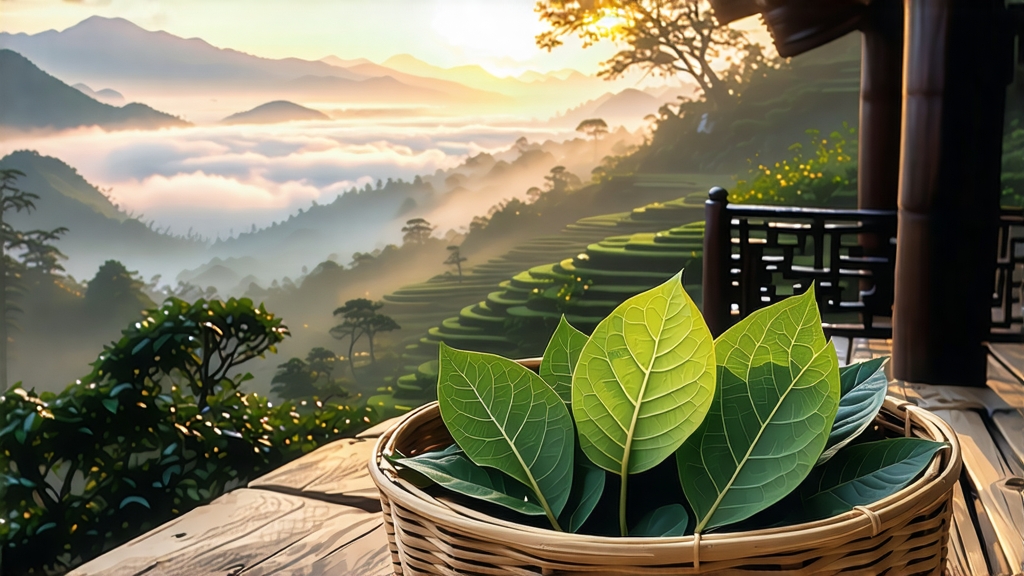
Alishan High-Mountain Oolong, known in Taiwan as “Alishan Qing Xiang Oolong,” is the island’s most celebrated gift to the world of tea. Grown between 1,000 and 1,400 meters on the forested spine of the Alishan range, the cultivar absorbs 2,000 mm of misty rainfall a year, ten-degree day-night temperature swings, and ultraviolet light so intense that the leaves thicken their cell walls, hoarding glutinous sweetness and a signature alpine bouquet reminiscent of orchid, white peach, and fresh cream.
History
Although Chinese immigrants brought tea bushes to Taiwan in the late 18th century, Alishan’s tea story begins in 1895 under Japanese colonial rule. The colonial government, eager to rival Assam and Ceylon, mapped the island’s highlands for camellia sinensis. Seedlings of the Qing Xin (Green Heart) cultivar—originally from Fujian’s Wuyi cliffs—were transplanted to Alishan’s virgin cedar forests. After World War II, Kuomintang veterans refined the plucking standard to “one bud, three leaves,” and by the 1980s Alishan Oolong had become the flagship of Taiwan’s emerging high-mountain category, commanding prices higher than many Grand Cru Burgundies.
Terroir & Gardens
Alishan is not a single mountain but a 20-km ridge of ancient basalt and shale thrust upward by the Philippine Sea Plate. Volcanic soils, rich in iron and magnesium, drain quickly, forcing roots to dive three meters in search of water, concentrating amino acids. At dawn, clouds born from the nearby Taiwan Strait roll uphill, condensing into a shimmering veil that acts like a natural shade cloth, slowing photosynthesis and boosting L-theanine. Gardens are intentionally small—rarely more than five hectares—interplanted with indigenous cedars whose roots share mycorrhizal fungi with the tea bushes, adding a subtle resinous note to the finished leaf.
Cultivars
While Qing Xin remains the aristocrat, farmers now graft it onto hardy Assamica rootstock to resist root rot. A micro-lot called “Golden Dayuling” is Qing Xin mutated by ultraviolet exposure, yielding leaves edged in ochre that steep into a honeyed liquor. Another garden nurtures the elusive “Black Jade” cultivar, a hybrid of a wild Taiwanese camellia and a Burmese assamica, which produces a cocoa-like undertone beneath the alpine florals.
Plucking Calendar
The mountain sleeps until late March when night temperatures finally stay above 8 °C. The first flush, “Spring Mist,” is plucked between Qingming and Guyu—usually a 14-day window—when leaves are velvet-soft and amino acids peak. A lighter summer harvest follows in July, but the monsoon air thickens cell walls, yielding a greener, more astringent cup. The most prized lot is the winter “Frost Dew” picked in late October after the first cold front; intracellular ice crystals rupture membranes, releasing bound aromatics that survive the long, slow bake.
Craft: From Leaf to Jade Pearl
Within minutes of plucking, leaves are solar-withered on bamboo trays set on open-air balconies, losing 8 % moisture and triggering grassy volatiles. Indoors, they are tossed in tumbling bamboo drums for three hours, bruising edges just enough to invite oxidation enzymes while leaving the leaf center emerald—a hallmark of partial oxidation (20–30 %). Once the leaf emits a ripe pineapple fragrance, oxidation is halted by a 260 °C tumble in an electric wok for 90 seconds, a step locals call “killing the green.”
The still-warm leaves are wrapped in cotton cloths the size of pillowcases and rolled under mechanical pressure into tight hemispheres; this repeated bundling and unbundling—up to 60 cycles—forces residual moisture outward, locking aromatics inside a crystalline structure. Finally, the pearls are charcoal-baked for six hours over longan wood embers hovering at 80 °C. Master roasters judge readiness by ear: when the leaf crackles like thin ice, it is removed and rested for a month so the charcoal phenols integrate.
Grading & Nomenclature
Alishan Oolong is sold under four grades. “Super Fine” indicates leaves harvested before 9 a.m. from unpruned bushes older than 30 years. “Fine” allows mechanical harvest but only from slopes above 1,200 m. “Standard